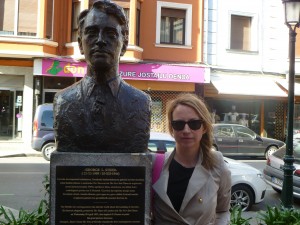Next Stop: Guernica
ALBA Board Member Soledad Fox recently sent me this lovely dispatch about an excursion she led of US college students to the town of Gernika in the Basque Country. A professor at Williams College, Fox is the author of the outstanding book about Constancia de la Mora, In War and Exile: International Voice for the Spanish Republic, which has just been re-issued in paperback under the title: A Spanish Woman in Love and War.
While planning a recent trip for a group of students to Bilbao and San Sebastián, it struck me that we would be very close to Guernica. These students were undergraduates, not Spanish Civil War specialists. I was curious to go visit Guernica, but it would mean taking a detour on the way to San Sebastián. I mentioned the possibility to a few Basque experts who discouraged me saying there was nothing to see there and that it was an ugly town. If it rained, I would be really sorry.
In the end I decided not to take their advice, and dragged thirty guileless students, two guides and a colleague to Guernica. They had all studied Picasso’s painting, of course, but this was still not enough to justify a stop on the itinerary that was bound to pale compared to the Guggenheim Museum or the Concha beach.
I had promised my colleague that I would speak at Guernica to explain why we were all there, but I had no idea what to say. How could I link this now peaceful, modern town to the painting?
The answer finally came to me: George Steer. (1909-1944). Steer was the correspondent for the London Times during the Spanish Civil War, and wrote a wrenching report from Guernica after the bombing. His article was published in the Times on April 27, 1937 and was subsequently bought and translated by every major international newspaper.
Picasso, who was in Paris working on a piece for the Spanish Pavilion of the International Expo, read Steer’s article. He dropped what he was doing and began work on what would become one of the most famous paintings of all time.
I talked to the students about this as we stood near the now scraggly tree of Guernica. It was a clear sunny afternoon, and happened to be around the same time the bombing started on that infamous market day 74 years ago when I read them some excerpts of Steer’s article:
“Monday was the customary market day in Guernica for the country round. At 4.30 pm, when the market was full and peasants were still coming in, the church bell rang the alarm for approaching aeroplanes, and the population sought refuge in cellars and in the dugouts pre pared following the bombing of the civilian population of Durango on March 31, which opened General Mola’s offensive in the north. The people are said to have shown a good spirit. A Catholic priest took charge and perfect order was maintained.
Five minutes later a single German bomber appeared, circled over the town at a low altitude, and then dropped six heavy bombs, apparently aiming for the station. The bombs with a shower of grenades fell on a former institute and on houses and streets surrounding it. The aeroplane then went away. In another five minutes came a second bomber, which threw the same number of bombs into the middle of the town. About a quarter of an hour later three Junkers arrived to continue the work of demolition, and thenceforward the bombing grew in intensity and was continuous, ceasing only with the approach of dusk at 7.45. The whole town of 7,000 inhabitants, plus 3,000 refugees, was slowly and systematically pounded to pieces. Over a radius of five miles round a detail of the raiders’ technique was to bomb separate caserios, or farmhouses. In the night these burned like little candles in the hills. All the villages around were bombed with the same intensity as the town itself, and at Mugica, a little group of houses at the head of the Guernica inlet, the population was machine-gunned for 15 minutes.”
I have rarely had such a captive audience, or spoken in such a charged setting. The group was quite surprised that Picasso’s painting owed so much to a war correspondent they had never heard of.
Steer’s memory, in turn, owes quite a lot to Picasso’s memorialization of Guernica’s destruction. In 2006 the town named a street after Steer, and unveiled a bronze bust in his memory. We finally found the statue on a small street near the town hall, and the plaque underneath it clearly says (in Basque, Spanish and English) that his historic dispatch inspired Picasso to paint his great picture Guernica.
Steer’s full article can be found at:
http://www.timesonline.co.uk/tol/news/world/europe/article709301.ece













